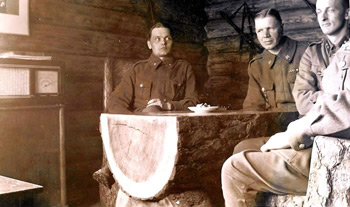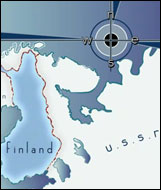

The breaking of the Mannerheim Line on the Karelia Isthmus was the key area of the entire Winter War. If the Soviets could break the line and take the city of Viipuri (now Russian city Vyborg) – which was Finland’s second largest city, the gateway to Helsinki would be open. As such most of the concentration of Finnish troops was on the Isthmus area since this would be the area of prime concern if there was a Soviet attack. At 8am the Soviet attacks began - Over 120,000 men strong with over 1000 tanks in support as well as heavy artillery and airpower.
The first attacks by the Red Army meet with great success. The Finns had never encountered tanks in combat before and found stopping Soviet armor was a major problem. This was in part due to the lack of proper anti-tank weapons as the front line Finnish soldiers had little to stop armored attacks. The Soviet armored units forced the Finns backwards and in many cases caused widespread panic. By December 1st Stalin decides to install a new Finnish government in the newly captured city of Terijoki. There was no Finnish citizen support for what Stalin called the “Democratic Government of Finland". Otto Kuusinen, a former Finnish communist who was exiled from Finland after his actions in the Finnish War Of Independence, heads this false government. The forming of this government has the effect of Finns becoming even more fervent in their fight as clearly Stalin plans to make Finland a pawn of the Soviet Union.
The main goal of the Finnish Army was to this point to delay the Soviet attacks and although the Soviets had been successful in their advance – most of the Finnish troops were still intact. The Finns regrouped behind the more solid positions of the Mannerheim Line and awaited the coming Soviet attacks. The Finns used a large amount of booby traps on the Soviet troops in the areas the Finns vacated. These actions did indeed slow down the Red Army advance and allowed the main body of the Finnish Army to form and plan for the coming Soviet attacks.
Taipale
Taipale is a village located at the far left flank
of the Finnish defense lines. The Soviet attacks in this area took
the Finns by surprise as the Summa sector (closer to the right flank)
was thought of as the most important area of defense and as such
the Taipale sector was held only by the Finnish 10th Division. The
Finns had the general area well defended and felt that the only key
area the Soviets could attack was a rather open space of land. This
area had been pre-sighted by Finnish machine guns, artillery, and
mortar crews before the attack took place and gave the Finns a great
advantage if this area came under attack. The attack began with a
massive artillery barrage followed by a Soviet attack towards the
Lossi ferry area (river crossing) but these attacks were halted by
the Finns. The Soviets then did what the Finns had hoped would happen
as the Soviets concentrated their attack in the open area the Finns
had pre-sighted. The first Soviet attacks on this area near Koukunniemi
were almost wiped out to the man by Finnish artillery. The Soviets
attacked for 2 days but never had any success as these areas became
a killing field of dead Red Army soldiers. They lost 18 tanks and
a large number of men in this time frame. By Christmas there are
three Russian divisions in this action and they are joined by a forth.
The Soviet divisions are the 49th, 150th, 142nd, and the last to
join was the 4th. The Soviets are able to make a small breakthrough
as they attack at Kelja but after Finnish counterattacks the Soviets
are pushed back once again. After the first rounds of fighting the
battle in this sector moved into a more static phase. On December
25th the Soviets once again attacked the Taipale area with the main
focus of the attack on the 10th Division. The attack lasted three
days with the Soviets using the frozen ice (lakes) to try and advance
on the Finnish positions. These attacks came from infantry, artillery,
armor, and by air. The attacks were fierce but once again this sector
was held. As was the case in the first attacks in this region the
Finns could not spare reserves for this battle, so the Finns already
in position had to hold their ground with no outside support.

Civil Guard members in their dugout November 1939.
Brent Snodgrass
Summa
Summa was possibly the most important of all the sectors
on this front. Summa was the key to the so-called Viipuri Gateway,
which leads to the Finnish city of Viipuri, which in turn leads to
the capitol of Helsinki. Summa’s fall would mean the Soviets
could advance to this Finnish city and thrust deep inside of Finland.
This area was attacked by the Soviets on December 17th starting with
massive artillery strikes. The Soviets then committed 120,000 men
and at least two tank brigades on the Summa attacks. The fighting
here was heavy and waged on till the night of December 20th. The
Finnish 5th Division had held. The Soviets had lost at least 50 tanks
and thousands of men in these attacks. This battle is called the “Miracle
Of Summa” as it was a battle the Finns should not have (on
paper at least) won. This area, and the connected Lähde sector,
were to hold until later Soviet attacks in February.
Finnish II Corps Counter Attack
As the Finns had been able to repel
the Soviet advances the idea of a Finnish counterattack started to
grow as the Finns felt the Soviets were weak at certain points. There
was also the feeling that the Soviet soldiers were demoralized and
would be suffering. The commander of the Finnish II Corps was Lt.
General Öhquist and he was one of the main proponents of the
Finns taking such an agressive action. Öhquist appealed to Mannerheim
to let such an attack take place which was an idea that Mannerheim
was cold to at first. Öhquist stated that such an attack would
take the Soviets off guard and would destroy the forces that were
massing for another attack on the Finnish front lines. Mannerheim
did approve the plan but it is clear he had his misgivings about
such an action as Mannerheim felt the main goal of the Finnish Army
should be defensive in nature. On the 19th of December Mannerheim
attached the 6th Division to II Corp as the 6th Division would be
involved directly in this Finnish effort.
The attack was to be on a 25-mile front from Lake Koulemajärvi to Lake Muolaanjärvi. The attack spearhead would be of two parts lead by the 6th Division near Summa and the 1st Division near Lake Muolaanjärvi. The 4th, 5th, and 11th Divisions would be used as support units for this attack which was set for December 23rd. The attack was slated to start at 6:30AM. Sadly for the Finns the attack was not planned well and there was miscommunication between Finnish units. This was such a problem that some units were late in engaging the Soviets. The Finns also lacked a bit in reconnaissance and they were not fully aware of the exact locations of the Soviet troops that were to be attacked. The Finns also were having issues moving their troops to the designated positions as the roads the Finns used were clogged with traffic. As the Finns wanted the attack to be a surprise there was no artillery preparation done before the attack. However the artillery units that were to support the attack once it was underway were delayed due to the heavy traffic on the roads. Certain Finnish units did well in this attack and met only light resistance but overall most of the Finnish units came under heavy fire. The Finns had issues with their communications networks and in many cases the various units had no idea what was taking place on other areas of the battlefield. The 6th Division took the brunt of the Soviet fire and the Finnish losses were quite high. The Finnish advance was stopped only 8 hours after its start and the operation would have to be viewed as a major disappointment. Over 1,300 Finns were killed, wounded, or missing in action in this ill-fated attack.





